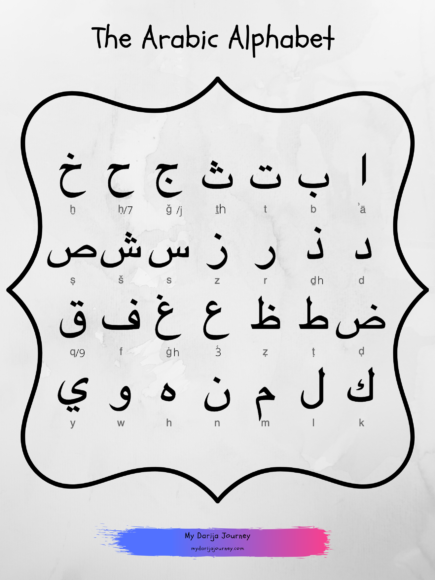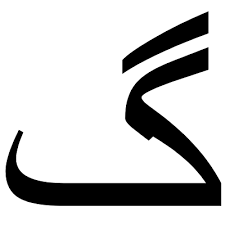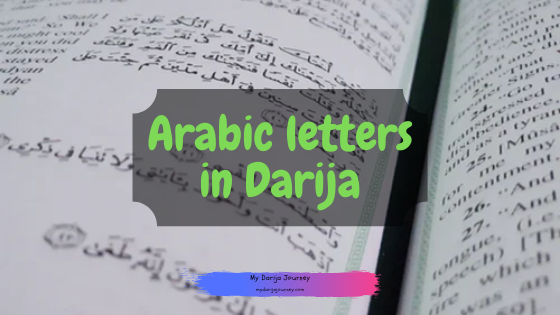I’ve mentioned that when learning Darija, I prefer to use Latin script instead of the Arabic script. However, some of you may be learning Darija from sources that use Arabic or may have an Arabic background before starting to learn Darija. Whatever your reason may be, I think it would be a good idea to review the Arabic letters in Darija.

Arabic letters in Darija are similar to the Modern Standard Arabic letters. They are read from right to left instead as opposed to the right to left like in English, French other languages. When using Arabic letters in Darija, the same rule applies. Unlike using the Latin script for Darija, where some numbers are used to represent some of the sounds foreign to other languages, the Arabic letters in Darija contain all the sounds needed so no numbers need to be inserted into the Arabic script. Here are the topics we will cover with Arabic letters in Darija.
Alphabet
I mentioned the alphabet in another post (please see Learning Moroccan Arabic – the definitive guide) but we will briefly go through it again. Here is the list of the Arabic letters

Each of the letters has a corresponding sound which is represented by the Latin letter below it. I’ve already explained this in the definitive guide so let’s look at some examples of the sounds of these Arabic letters.
| Arabic Letter | Example of the sound |
| ا | Apple |
| ب | Boat |
| ت | Train |
| ث | Tree |
| ج | Jeep |
| ح | Hallow |
| د | Dog |
| ر | Rain |
| ز | Zebra |
| س | Sea |
| ش | Shine |
| ص | Sold |
| ض | Door |
| ط | Told |
| ظ | Zoro |
| ف | Farm |
| ق | Corn |
| ك | Kangaroo |
| ل | Lamb |
| م | Mouse |
| ن | Night |
| ه | House |
| و | Way |
| ي | Yo-yo |
Writing

Like I mentioned earlier the Arabic script is read left to right so naturally the Arabic letters are written right to left as well. Another interesting thing is the Arabic letters in Darija are written together so in sentences the only thing that is separate is the words. Do you remember in school when you learned how to handwrite? I think some people also call it cursive writing. To those who never learned the skill of handwriting, it is basically the joining of letters when forming words. I learned this skill of handwriting when I was young and now I hardly see this form of writing. Well in Arabic this style of joining letters together to form words is how we write. By looking at the alphabet, the task of joining letters may seem daunting but Arabic makes it easy by morphing the letters when joining them. We will look into this further.
Joining letters
The morphing of the letters is a necessity in order to join the letters in Arabic. Once you start practicing writing, you will notice some similarities. This is not as hard as you might think. Let’s take a look below.
| Letter | Beginning of the word | Middle of the word | End of the word | Notes |
|---|---|---|---|---|
| ب | بـ | ـبـ | ـب | This letter can be identified as having 1 dot at the bottom. |
| ت | تـ | ـتـ | ـت | This letter can be identified as having 2 dots at the top. |
| ث | ثـ | ـثـ | ـث | This letter can be identified as having 3 dots at the top. |
| ج | جـ | ـجـ | ـج | This letter can be identified with the specific shape at the top of the letter and the dot at the bottom. |
| ح | حـ | ـحـ | ـح | This letter can be identified with a specific shape at the top of the letter. |
| خ | خـ | ـخـ | ـخ | This letter can be identified with the specific shape at the top of the letter and the dot at the top. |
| س | سـ | ـسـ | ـس | This letter can be identified with the 3 hooks. |
| ش | شـ | ـشـ | ـش | This letter can be identified with the 3 hooks and 3 dots at the top of the letter. |
| ص | صـ | ـصـ | ـص | This letter can be identified with a circle and a hook. |
| ض | ضـ | ـضـ | ـض | This letter can be identified with a circle, a hook and a dot at the top of the letter. |
| ط | طـ | ـطـ | ـط | This letter is pretty much the same in any position. |
| ظ | ظـ | ـظـ | ـظ | This letter is pretty much the same in any position. |
| ع | عـ | ـعـ | ـع | This one is a bit trickier. At the beginning of a word, the letter looks similar to the top of the letter but in the middle and end the letter has a different shape. |
| غ | غـ | ـغـ | ـغ | This one is a bit trickier. At the beginning of a word, the letter looks similar to the top of the letter but in the middle and end the letter has a different shape. |
| ف | فـ | ـفـ | ـف | This letter is identified by the loop and the dot at the top of the letter. |
| ق | قـ | ـقـ | ـق | This letter is identified by the loop and the 2 dots at the top of the letter. |
| ك | كـ | ـكـ | ـك | This is a bit trickier. The letter is similar at the end of a word. At the beginning or middle of the word, the letter takes a different shape. |
| ل | لـ | ـلـ | ـل | This letter is identified by the line. At the end of the word, the letter has a shape similar to the letter by itself. |
| م | مـ | ـمـ | ـم | The letter is identified by the circle |
| ن | نـ | ـنـ | ـن | This letter can be identified as having 1 dot at the top. |
| ه | هـ | ـهـ | ـه | This letter is the most difficult as each position the letter looks different. This is probably the only letter that will give you trouble. However, this is the only letter that has different shapes for each position. |
| ي | يـ | ـيـ | ـي | This letter can be identified as having 2 dots at the bottom. |
Exceptions to joining
All letters can be attached to letters except for a few letters. These letters basically have an empty space after the letter is attached. In the beginning, this can be confusing. It’s better to know these letters to be aware of this exception. The following table shows you the letters that can’t be joined with any letter after.
| Letter | Middle/End |
|---|---|
| ا | ـا |
| د | ـد |
| ذ | ـذ |
| ر | ـر |
| ز | ـز |
| و | ـو |
Vowels
Around the time that I started this site, I wrote something about trying to find vowels in Darija words. With Arabic letters in Darija, you see consonants. The vowels do exist but are not shown in the written language. The following are the vowels for the Arabic letters in Darija.
A/ ا
The sound of this vowel is ‘A’ as in apple or Tajine.
I/ي
The sound is this vowel is ‘I’ but it’s more of a sound like ‘eee’ like Tajine.
U/و
The sound of this vowel is ‘U; but it’s more of a sound like ‘ooo’ like igloo.
Because the vowels are not shown, you will need to know what the sound is. I’ve tried to find ways of finding out the sounds, but in the end, you just need to know by practice and experience. With vowels, there are certain letters that can be used to lengthen the sound of that vowel.
Lengthening
When the vowel is followed by one of these letters
- ا
- ي
- و
The vowel is lengthened. For example, let’s look at the word كتاب – book (notice the after the ا the ب is not joined). This word is pronounced ktab. The reason why it is ktab and not ktb is the ا which lengthens the ‘A’ sound. For ‘ ا ‘, the letter although recognized as a letter in the alphabet is normally used to lengthen a sound in a word. To actually use the letter, it needs a special letter attached to it, the hamzah.
hamzah
This letter is very interesting and would take a long time to explain all the uses and grammatical purposes in Arabic. I’m just going to briefly explain how the letter is used in Arabic letters in Darija. The hamzah is used in two ways.
- Used to give a sound to the ‘ ا ‘
- It shortens the sound of a vowel
Here are some common places you will see hamzah.
- أ – the sound is similar to ‘A’ or ‘U’
- إ – the sound is similar to ‘I’
- ؤ – the sound is similar to ‘A’ or ‘U’ and shortens the vowel
- ـؤ – the sound is similar to ‘A’ and shortens the vowel
- ئ – the sound is similar to ‘A’ or ‘I’
- ئـ – the sound is similar to ‘A’ or ‘I’
- ـئـ – the sound is similar to ‘A’ or ‘I’
- ـئ – the sound is similar to ‘A’ or ‘I’
In short, using hamzah is based on the knowledge of the word. Using it with ‘ ا ‘ is simple enough when messaging with friends, you can omit the hamzah and writing in a more formal tense you just add it to create the sound but when using it in other contexts, using it will just come down to you knowing how the word is spelled.
Darija specific letters
Finally, let’s look at a few letters that are not in standard Arabic.

This is the sound of ‘G’ as in gum. In standard Arabic, the ‘G’ sound is often represented with the letter غ however غ is more of glottal or back of your throat sound so technically it’s not the same. If you ever get a chance to go to Morocco, you may see this letter used in signs.

This letter represents the ‘P’ sound. The ‘P’ sound is not a sound used in Arabic. In standard Arabic, the ‘P’ sound is often replaced with ‘B’. For instance the country Pakistan is pronounced as Bakistan in Standard Arabic. I have not seen this letter in use but it does exist.
Want to learn more? Join the Discord server https://discord.gg/QC4w5NCtM4
Final thoughts
While I do have the knowledge of reading and writing Arabic letters in Darija, I choose to use the Latin script. I feel that since the Darija language is influenced by other cultures and languages so using the Latin script would be easier to incorporate some foreign words. Still, it’s nice to know there is a way to use Arabic letters in Darija. For those of you using other resources to learn the Darija language, use this post as a reference on the letters. If you have any questions please let me know and I’ll help you out.
 If you are interesting in learning Arabic, there is a free 6 day course that will teach you everything you need to know to get started. Arabic has helped me a lot with my darija journey. If you’re serious about learning just click on the laptop and begin your journey.
If you are interesting in learning Arabic, there is a free 6 day course that will teach you everything you need to know to get started. Arabic has helped me a lot with my darija journey. If you’re serious about learning just click on the laptop and begin your journey.

I had not seen before that P doesn’t make the same P sound in English. Thank you for your post.